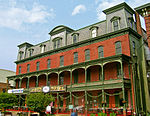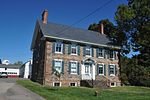Watchung Outliers
Jurassic volcanismMountain ranges of New JerseyMountains of New JerseyMountains of New York (state)Mountains of Pennsylvania ... and 7 more
Ridges of New JerseyTriassic volcanismVolcanism of New JerseyVolcanism of New York (state)Volcanism of PennsylvaniaVolcanoes of the United StatesWatchung Mountains
The Watchung Outliers include six areas of isolated low hills and rock outcrops of volcanic and sedimentary origin in the U.S. states of New York, New Jersey, and Pennsylvania. These geologic outliers are primarily diminutive and detached remnants of the Triassic/Jurassic age Watchung Mountain basalt flows with intervening layers of sedimentary rock. All six of the outliers are found along the western edge of the Newark Basin, occupying small synclines adjacent to the Ramapo fault system. The outliers, from north to south, are known as: Ladentown, Union Hill, New Germantown/Oldwick (including Round Top), Prospect Hill, Sand Brook, and Jacksonwald.
Excerpt from the Wikipedia article Watchung Outliers (License: CC BY-SA 3.0, Authors).Watchung Outliers
Bonnell Street,
Geographical coordinates (GPS) Address Nearby Places Show on map
Geographical coordinates (GPS)
| Latitude | Longitude |
|---|---|
| N 40.511 ° | E -74.866 ° |
Address
Bonnell Street
08822
New Jersey, United States
Open on Google Maps






